Denon AVR-X2500H Review
The Denon AVR-X2500H is an AV receiver aimed at all home theater (5) and music fans (1) from Denon (2) who are looking for a modern device for perfect surround sound (6), integration with HEOS speakers (4), and do not want to do without any technical amenities (3). It offers quick integration with streaming services via an app (7) that can communicate wirelessly (8) with loudspeakers via WLAN (9) and can be controlled via remote control, smartphone app, or Amazon’s voice assistant Alexa (10).
The Denon AVR-X2500H is the perfect candidate in the entry-level: it offers all modern connections. Of course, Denon also supports streaming services such as Spotify or Deezer, multimedia playback via USB and wireless playback via Apple Airplay 2, Bluetooth or DLNA.
We have also the updated review for the Denon AVR-X2700H, that is a much more advanced model, released in 2020
Denon’s new 7.2-channel receiver, just like the AVR-X1500H, is only available in a black version. It weighs 9.4 kg and is 434mm wide, 167mm high, and 339mm deep.
From the outside, you can not see many changes (compared to the previous AVR-X2400H), but the central part with the display and most of the buttons have been subtly extended. The volume and source selection will be set with knobs.
With this receiver, you can set up a powerful home cinema setup with up to 7.2 channels. The number “7” stands for the possible power amplifier speakers (one at the front, two at the side, two at the back, two at the top), and the “.2” for the number of connectable subwoofers for rich bass.
The Denon can, therefore, drive two dedicated subwoofers.
Those who are new to the world of audio and video formats can easily be overwhelmed by the technical terms. But with the Denon AVR-X2500H, it is different: it plays all modern formats, passes videos in full quality to your television, and can even scale up low-resolution images to 4K quality.
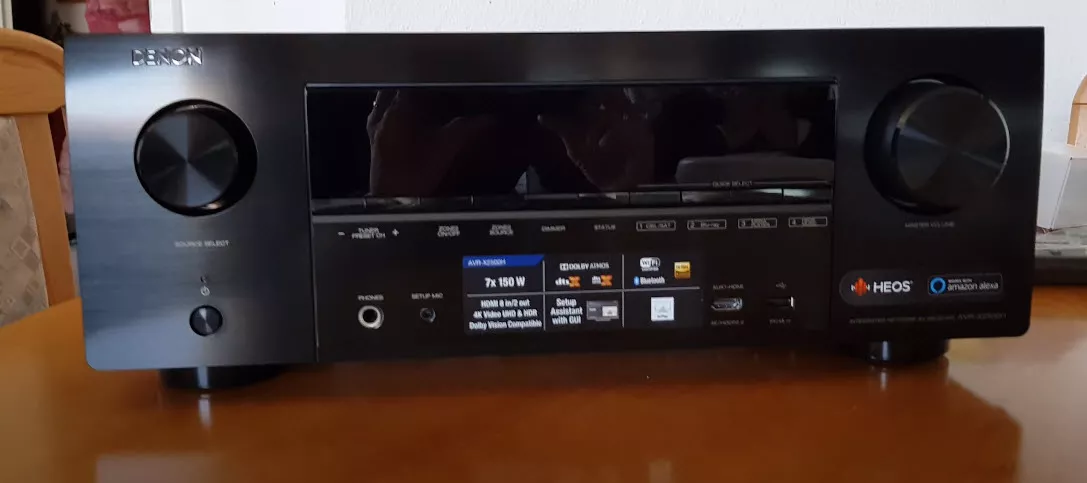
The Denon AVR-X2500H romps around in the highly competitive price range around 700 dollars. With its extensive equipment, HEOS integration, and an optical facelift, it is sure to meet the taste of audio/video fans.
The Denon has undergone a successful facelift by its makers: it appears fresher, more contemporary, and, all in all, even more, valuable than the previous generation. In terms of equipment, Denon has just about everything that home cinema fans could wish for onboard. Dolby Atmos and DTS:X support the latest 3D audio formats, while Auro-3D is missing from the list.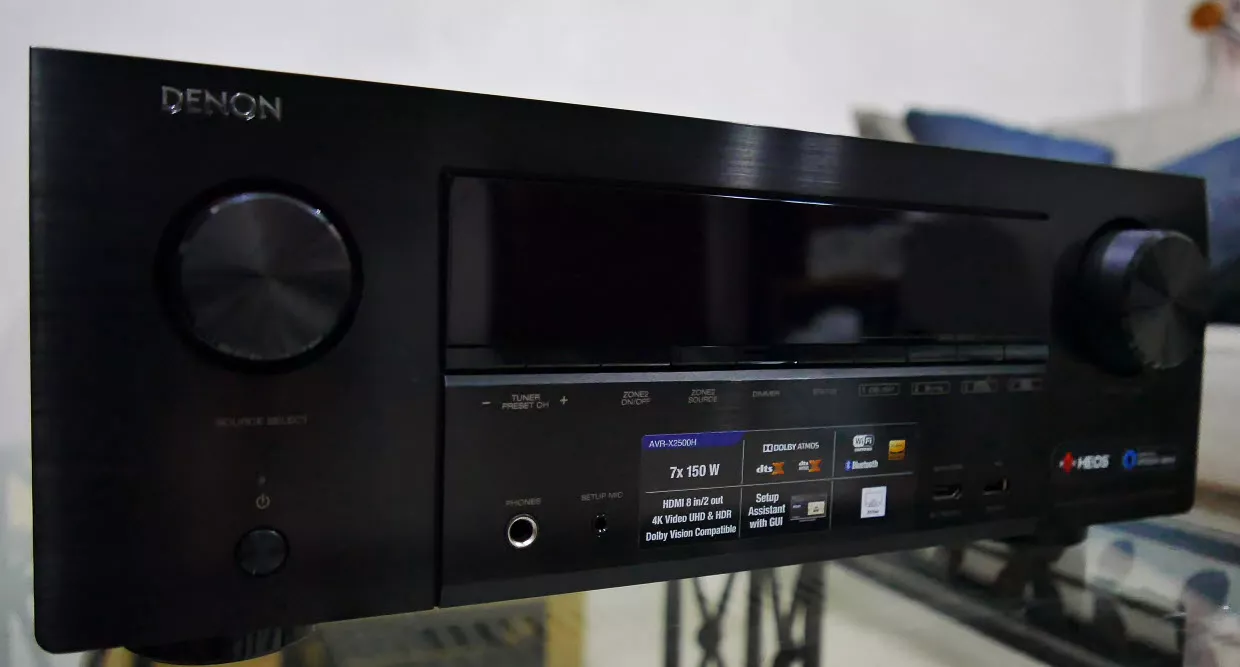
The 7.2 channel can drive 5.2.2 loudspeaker setups or provide surround sound in the classic style with 5.1 or 7.1 systems.
Thanks to DTS Virtual:X, the Denon AVR-X2500H can transport immersive cinema sound into the listening room without the need for treble channels.
The latest video standards are on board, so the 4K Ultra video features are not a concern for buyers. The HDCP2.2 copy protection codec is supported by all HDMI connections: seven inputs on the rear, one on the front, and two outputs on the rear. Also on the credit side are 60 Hz 4K Ultra-HD video, Pure Color 4:4:4 subsampling, Dolby Vision, HDR10, HLG, BT2020 pass-through, and 21:9 video.
Network audio streaming and USB playback allow high-resolution audio formats such as FLAC, ALAC, WAV, and DSD up to 5.6 MHz to be played back. Streaming services such as Tidal or Deezer are all integrated into the HEOS app. Via updates, the Denon AVR-X2500H is also compatible with Amazon Alexa since 2020.
Technically speaking, the Denon AVR-X2500H supports the latest 3D audio formats Dolby Atmos, DTS: Virtual X, and DTS: X and also has those with 4K Ultra HD, Dolby Vision, HDR10, 4: 4: 4 color resolution, BT.2020 and HLG latest video technologies on board. It has eight HDMI inputs and two HDMI outputs with HDCP 2.2 support including full-rate passthrough on all ports.
The Denon AVR-X2500H has separate high-current amplifiers on all channels and is therefore particularly powerful: 150 watts per channel (8 ohms, 20 Hz – 20 kHz, 0.08% THD). Low impedance drivers ensure functional stability for many speakers and a balanced, full sound. Denon was hardworking and diligently revised its AV receiver division in 2017. It all started in February with the flagship AVC-X8500H, which is based on the design of the brand new Denon AVR-X2500H. In the course of this facelift, the bezel around the display and front panels fell away and the control buttons connect to the display almost invisibly. Overall, the front – which is still made of plastic – looks quieter and more elegant than before.
Denon takes the signs of the times into account with a phono input, after all, turntables are back in fashion. Also in fashion and therefore also possible with the Denon AVR-X2500H: Streaming via DLNA, AirPlay, and Bluetooth, supplemented by Internet radio and other online services. Home theater fans benefit from seven HDMI inputs and two outputs, and Denon has also saved on analog video jacks. Analog and digital audio inputs must of course not be missing, although the latter is unfortunately only available in optical form. An adapter is therefore required for sources with a coaxial output.
On the back of the Denon AVR-X2500H, we spotted the added phono input for connecting a turntable, which is again very fashionable. Very beautiful! The Japanese also created a hand on the video board, which now enables the menu overlay for Dolby Vision and HLG signals. The improved eco mode “Auto” is intended to counteract the development of excessive heat and thus hot housing covers.
In addition, the power amplifiers, DACs, and DSPs have been optimized for even better sound. The web interface for setting and operating the device via a classic Internet browser is possible since 2020 via a firmware update. The function fell under the table when HEOS was introduced. The integration of Apple’s AirPlay 2 via subsequent firmware was also rolled out in 2020.
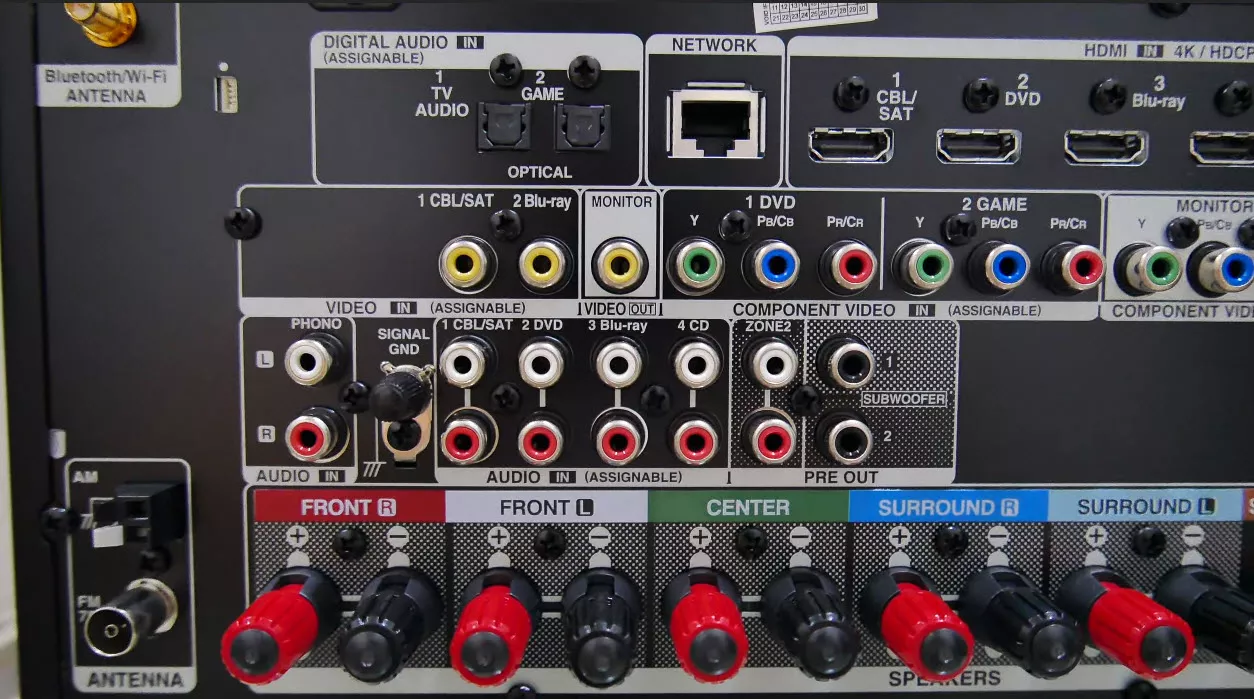
The Denon has the new DTS Virtual: X tone decoder onboard, but its use does not work in conjunction with the Audyssey automatic calibration system. Of course, Dolby Atmos and DTS: X as well as their upmixers Dolby Surround and DTS Neural: X are also included. Both allow cross-format upmixing, but not with native 3D sound. Denon’s Auro decoder is only available in larger models. Last but not least, the receiver is fit for voice control with Amazon Alexa, which, however, requires an “Alexa” compatible speaker.
The power of the power amplifiers is 150W / channel (1 kHz, 1% THD, 1 channel modulated) and is therefore slightly higher than the power of the power amplifier unit in the AVR-X1500H. The Denon AVR-X2500H also has a built-in Heos module and Audyssey MultEQ XT including Dynamic Volume and Dynamic EQ. Of course, the Denon setup wizard is not missing on the 2500H, and the phono input is also part of the Denon AVR-X2500H.
What performance data and what features does the Denon AVR-X2500H offer? It is also Amazon Alexa compatible and supports Dolby Atmos, DTS: X and DTS Virtual: X. In contrast to the AVR-X1500H, the Denon AVR-X2500H has eight HDMI inputs (all with Dolby Vision, HLG, HDR10, HDCP 2.2) and two HDMI outputs.
Pros And Cons Of The Denon AVR-X2500H
Pros And Cons
Pros
- Dolby Atmos, DTS:X and DTS Virtual:X, 4k upscaling, and Dolby Vision.
- Full 4K equipment with HDR, scaler, and EQ
- Integrated HEOS Multiroom
- PHONO input to connect a turntable device.
- Very solid output and excellent handling of sound.
Cons
- Front made of plastic. It does not look cheap but I preferred more noble materials.
- Equalizer only regulates from 63 Hertz
- No coaxial digital input.
- Not better than the Sony STR-DN1080.
- No 8K support, so currently, it is preferable to go for the improved Denon AVR-X2700H.
Connectors Available For The Denon AVR-X2500H
The Denon AVR-X2500H has a headphone output, a calibration microphone input, there is no analog input (included in the handset ), but instead, Denon installed something more (currently) useful – an additional HDMI input, and in the full 4K / HDCP 2.2 specification also with Dolby Vision, HLG or HDR10).
There is also USB in the front (mainly for storage media), which was an attraction here a few years ago, and now, in the era of wireless streaming (even using Bluetooth) and mobile equipment is losing importance. It is also difficult to prove that it is a handy “power bank”, because the maximum load capacity of the connector is only 1 A.
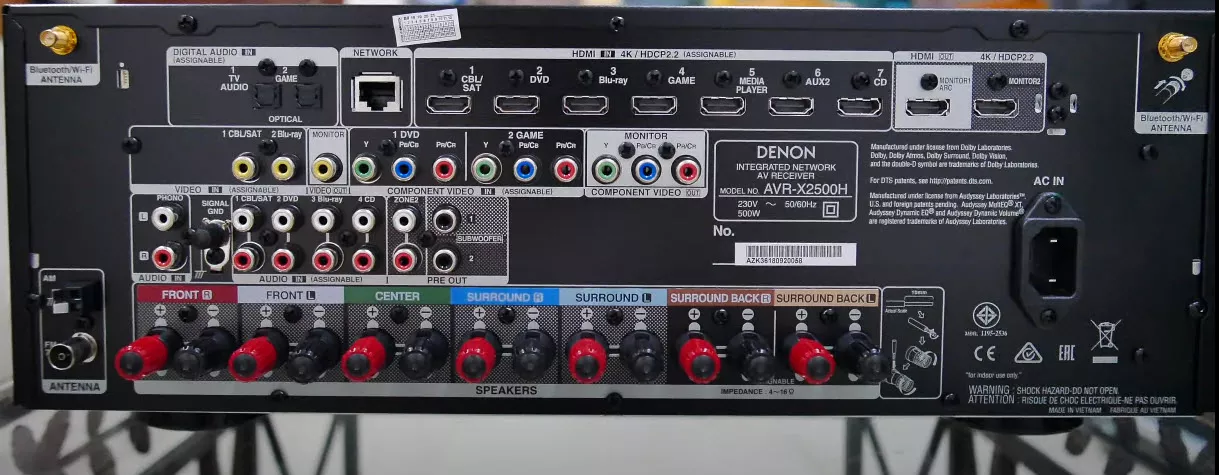
Denon AVR-2500H surprised by the richness of the HDMI section, we will connect seven sources and two receivers (e.g. TV and projector) on the back panel. All connectors use the 4K standard (together with HDCP 2.2), the device can also scale the signal.
There are two component inputs, two composite and one output for each, but the Denon AVR-X2500H does not have a video converter, so composite and component signals will have to leave the receiver in the same standards. There are three analog inputs, audio line (stereo), two subwoofer outputs, and one for a remote zone.
New awaited (in relation to its predecessor) is Denon AVR-X2500H input pickups. The digital connectors are limited to a pair of optical inputs, probably on the occasion of cooperation with the TV (when we do not want or cannot use the ARC return channel).
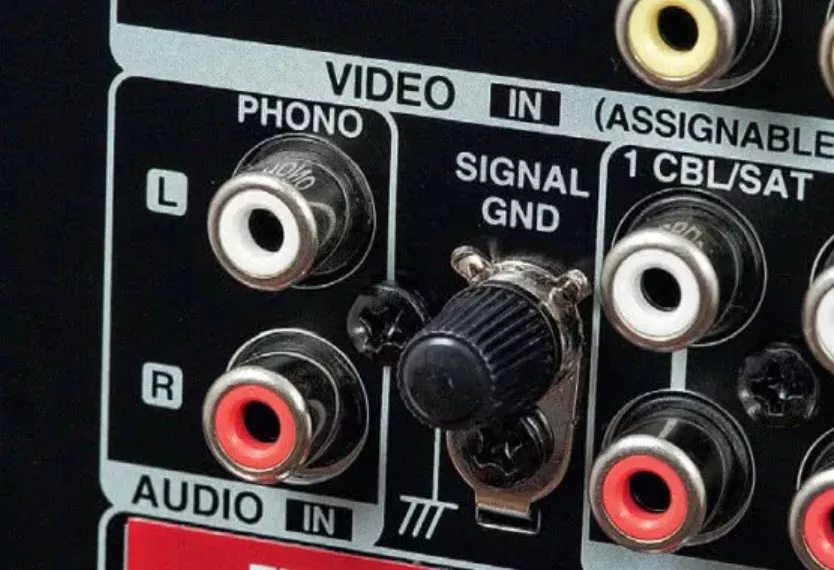
A phono input appeared; in the previous model, there was no such important add-on today.
The Denon AVR-X2500H is a 7.2 amplifier with seven power amplifiers. Their number corresponds to the number of pairs of speaker terminals, but there may be several variants of use. They are associated with the presence of both Dolby TrueHD, DTS HD decoders, as well as Dolby Atmos or DTS: X, each of them determines the layout, connection and positioning of the speakers.
Of course, the power amplification mode also allows you to set up a remote zone or bi-amping in the main room. The manufacturer allows work with 4-ohm columns in all channels (simultaneously). To do this, select the appropriate impedance selector option in the menu (there are even three – for 4-, 6- and 8-ohm columns).
Equipment and Features
Apart from the phono input already mentioned, nothing has changed in the connections: 8 HDMI inputs and 2 HDMI outputs are decent, the abundant presence of analog YUV and FBAS video sockets is atypical but pleasing for an entry-level receiver.
On the other hand, we find the lack of a digital coax input to be suboptimal, for which there are two Toslink sockets.
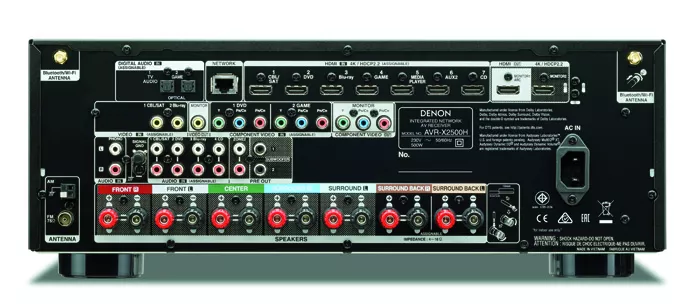
Rear: 7 HDMI, 2 S / PDIF, and 4 analog inputs are sufficient for most home cinemas. The phono board, which allows the connection of a turntable without a preamplifier, is pleasing. Height boxes for 3D sound must be connected to the “Surround Back” terminals. The antennas for WLAN and Bluetooth can be screwed on.
Like the AVR-X2400H, the successor comes with 7 discrete power amplifiers, which allow two additional height channels or two surround back boxes for 5.2 operations. Alternatively, the main loudspeakers can be bi-amped or two loudspeakers can be actively sonicated in another listening room; The latter is also possible via pre-outs.
There are no pre-outs for height boxes, which is why 5.2.2 layouts are over. The two height boxes can be defined as front or middle ceiling boxes as well as front height speakers or as top boxes (Dolby enabled) for the front or surround speakers; Top-back or height-back positions are not available. The two connectable subwoofers cannot be controlled separately.
A maximum of 7.2 or 5.2.2 channels are possible. Ceiling boxes can sit in the front or in the middle.
We have nothing to criticize about the speaker configuration, the level and distance steps are exemplary with 0.5 decibels and 1 centimeter, the crossover frequencies between 40 and 250 Hertz can be selected separately for all speaker groups. The levels of all speakers and bass/treble can also be saved separately and separately for each input source; The corresponding menus can be accessed via the “Option” button on the remote control.

Changes and improved components on the power amplifier, DACs, and DSPs should optimize the sound of the X2500H. Picture by Denon.
Denon has retained the extremely practical Quickselect function keys (four on the front panel and four on the remote control) to provide quick access to preferred sources, including individually stored audio settings, at the touch of a button.
The Denon receiver can feed two zones with different audio content, either via the speaker connection or an external amplifier via pre-out. The USB input on the front plays music from USB data carriers. Content from iDevices is played wirelessly via AirPlay.
HEOS registration and initial configuration is simple and thanks to a well-designed app, the operation is easy. In addition, there is the free app “Denon 2016 AVR Remote”, with which the receiver can be operated easily and clearly via smart devices.
Those who come into contact with an AV receiver for the first time will be pleased with the excellent setup wizard, which takes the user by the hand via a screen when the Denon AVR-X2500H is started for the first time. The explanations are easy to understand and the illustrations make getting started with home theater pleasure.
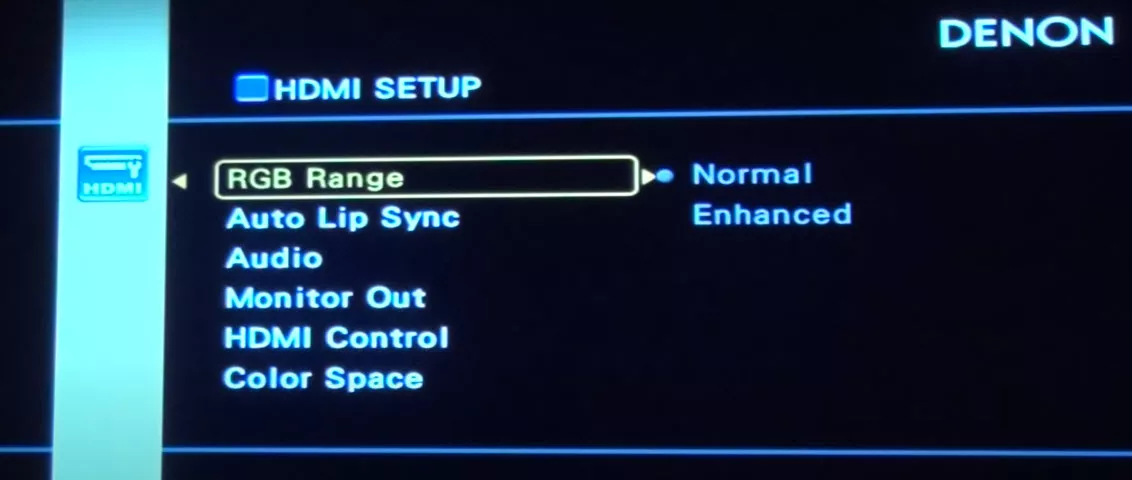
The installation also includes room and speaker calibration, which at Denon is carried out in a classic way using the Audyssey measurement system. For this purpose, there is a “cardboard rocket” in the box on which the measuring microphone can be positioned at ear level. Practical if no suitable stand is available at the moment.
Audyssey MultEQ XT measures at up to eight positions, at least three, around the reference listening position. Incorrectly connected loudspeakers are detected, the distances to the loudspeakers are determined and the sizes and crossover frequencies are specified. If you think you can do it better, you can of course configure the AV receiver completely manually.
Acoustical Correction Technology
Audyssey’s MultEQ XT is responsible for the automatic sound correction, which takes up to 8 measuring points into account, provides 3 target curves, and brings the sound circuits Dynamic EQ (Loudness) and Dynamic Volume (Dynamic reduction). Denon includes a cardboard stand for setting up the measuring microphone.
We perceive the equalizer as suboptimal, which only regulates from quite high 63 Hertz and excludes the woofer; the EQ also does not take effect when the calibration system is active. However, these weaknesses can be avoided with the “Audyssey MultEQ App”, which costs 20 dollars, with which you can manipulate various parameters of the Audyssey measurement and draw target curves yourself.
Audyssey MultEQ XT is an acoustical correction technology that calibrates a Denon A/V Receiver so that it can achieve optimum performance for every listener within a large listening area. There are two components to MultEQ XT: -Automatic Setup (Auto Setup) -Multi-listener equalization.
A modern receiver must have auto-calibration – for Denon, this is the Audyssey MultEQ XT system that also offers acoustic correction. An optional (subsequent) mobile application is also available (though you have to pay extra for it) that allows you to take a closer look at the calibration process and change the correction characteristics. But without it, the system works sufficiently effectively, which is enough for most users.
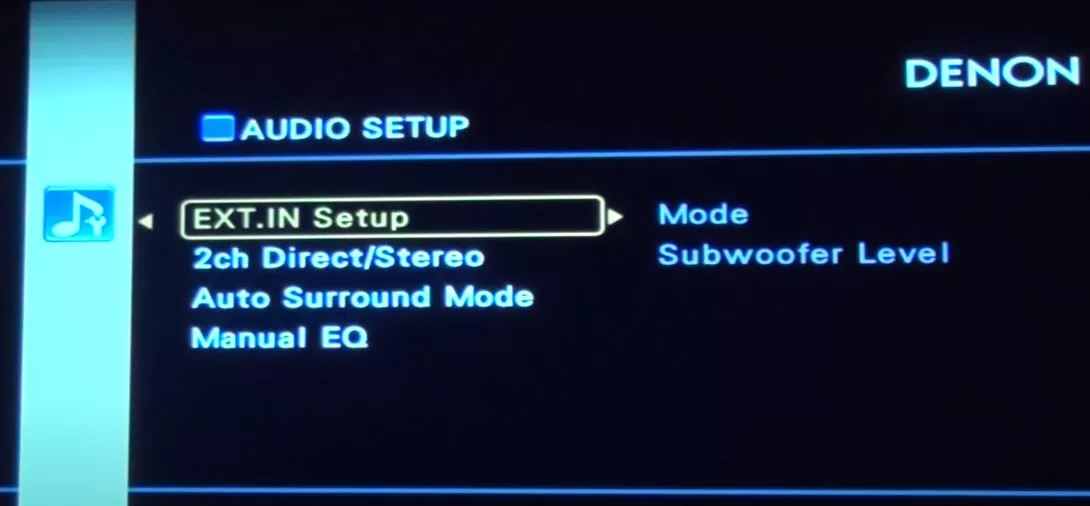
The Audyssey calibration worked without any problems. All parameters were set plausibly, which led to more control in the bass and a larger sound. The loudness circuit “Dynamic EQ” provided more volume and shine, but also loud surround boxes and coated basses. Dialogues also went down a bit. Audyssey Volume audibly reduced dynamic spikes in both DTS and Dolby sound.
The “Audyssey MultEQ Editor” app is optionally available in the stores at a price of around 20 euros for Android or iOS devices. The Audyssey settings made by the AV receiver can be checked and further adjusted. The app can also be used to initiate the measurement process. Using the Audyssey target curve, it is possible to manipulate each channel pair and optimize it to suit personal listening taste. Calibration settings can also be saved and restored.
For each channel pair, the total EQ frequency roll-off can be adjusted and switched between two target curves. It is also possible to activate or deactivate the mid-range compensation determined by Audyssey to change the sound. With this app, far-reaching influences are possible that further optimize the sound of the Denon AVR-X2500H. However, we would recommend this app to more advanced users or professionals because of the complex acoustics issue.
Video, Multimedia, And Connectivity For The Denon AVR-X2500H
The video section is a big difference to the Denon AVR-X1500H. Not only that, as already mentioned, there are two more HDMI inputs and one HDMI output, but also video processing, as was the case with the previous generation, is the difference. The Denon AVR-X2500H offers upscaling up to 4K for HDMI sources. However, currently, we have available the Denon AVR-X2700H that offers 8K and that we review here.
Bluetooth pairing was done without problems. The first attempt failed, we tried again and the pairing was completed easily, with a Pioneer and a Samsung TV.
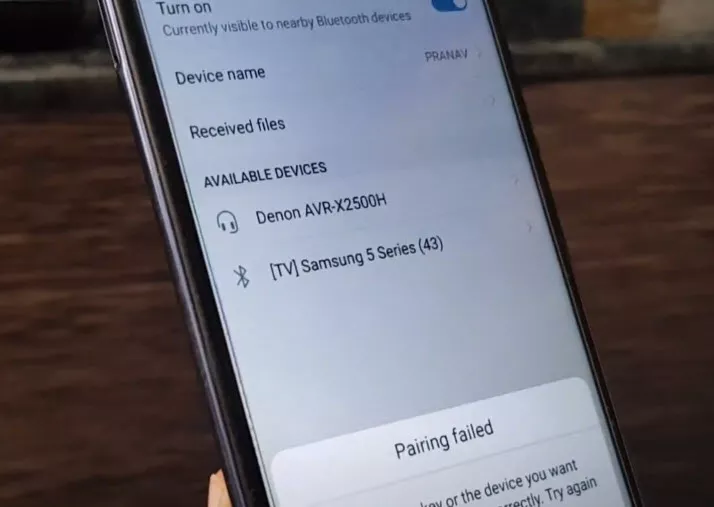
The video board accepts 4K / 60p images with HDCP 2.2, HDR-10, HLG, and Dolby Vision. The 4K scaling converts incoming HDMI signals up to 4K but does not work with analog input pictures. The video equalizer controls many image parameters sensitively, and there are six image modes, two of which comply with the ISF standard.
The media player understands hi-res audio with FLAC, ALAC, WAV, and DSD files. Networking with music is possible via DLNA, AirPlay, and Bluetooth, and control is most conveniently via the HEOS app. Denon has integrated Tune-In as web radio, streaming services such as Spotify, Juke !, SoundCloud, TIDAL, Deezer, Napster and Amazon Music have been outsourced to the HEOS app.
As part of Spotify Connect or AirPlay, the Denon AVR-X2500H will be self-sufficient, although we will reach for mobile equipment (or computer), so the Heosowa application will almost certainly be at hand. Denon AVR-X2500H can play (e.g. from local network servers or media connected to USB) PCM files (e.g. FLAC) 24 bit / 192 kHz and DSD in DSD64 and DSD128 variants. The receivers enter the “intelligent” phase in the 2018/2019 season, which means Internet and voice control.
Not only Denon focuses on the Amazon Alexa assistant, for which you will need the Amazon Echo Dot external adapter. We have both Wi-Fi (dual band) connectivity as well as a LAN, as well as wireless Bluetooth. Although smartphone drivers can grow more and some systems cannot be started without them, in many cases we will still appreciate the convenience of traditional remote control, especially as successful as Denon’s.
AirPlay System
The AirPlay system is an original Apple solution that has been in operation for more than ten years, which allows easy streaming of music, e.g. from smartphones, tablets (necessarily Apple) as well as computers. Initially, the system was hermetic and limited to Apple devices, but for a long time, it is also used for AV equipment from other companies, including wireless speakers, and above all receivers.
Its advantage was the use of a computer network and its high bandwidth for sending uncompressed PCM 16 bit / 44.1 stream. This, however, was impressive when streaming solutions were just beginning to appear, although the stability and convenience of using AirPlay put this system high in the popularity rankings.
Recently, Apple introduced the second generation – AirPlay 2 – to its devices and software, and Denon has already released the update for the Denon AVR-X2500H, as well as other models of receivers (which at the beginning were “AirPlay 2 ready”). The most important of the new possibilities is the creation of multiroom connections, i.e. streaming the same material from one source to many “receivers” AirPlay (1st generation) worked only in the point-to-point formula.
AirPlay 2 also tries to refer to the competition (even Sonos), expanding its functionality by, for example, naming its own zones, and Siri’s virtual “assistant” was also allowed to control the entire system. Finally, streaming has also become independent of phone calls that do not interrupt music in AirPlay 2.
The Denon AVR-X2500H (as well as other Denon models) are “receivers” in the AirPlay 2 system, the source can be either Apple mobile devices (e.g. iPhone) or computers (not necessarily Apple) with an iTunes music player installed.
Denon HEOS: Control And Streaming
The “H” in the name of the product “Denon AVR-X2500H” comes from its compatibility with the HEOS wireless speakers. So the Denon AVR-X2500H as a receiver can also be easily connected to Denon’s wireless HEOS speakers – the boxes do not have to be in the same room as the receiver. Because the HEOS apps for Android and iOS linked below allow you to control all the loudspeakers in a multi-room network and selectively play out content in a synchronized manner or control only individual loudspeakers.
We also connected the Denon AVR-X2500H via Bluetooth, wireless to the Devialet Gold (it also comes in silver, but as there is no difference between these models in the wireless connection, we have just tested in the Devialet Gold) It was also connected, this time via cables, with a headphone or with a bookshelf speaker without issues.
The HEOS apps also give you convenient access to streaming services such as Spotify, Deezer, Tidal, TuneIn, and more – directly via your smartphone or tablet.
Sound Quality
As always, our test devices have to compete with music and film for listening and viewing tests in stereo and multi-channel. So we test both, as we always do: audio tracks and movies.
The Denon AVR-X2500H starts with music from a USB stick, NAS drive and Blu-ray player. The powerful AV receiver reproduces the audio files in the listening room very cleanly. There is a lot of “blackness” underneath with the necessary pressure and great precision. This sounds nice and crisp and makes you want to keep on playing new tracks. We like the Denon in Pure Direct mode best.
The spatial reproduction succeeds excellently, the 2500 creates a wonderfully in width and depth building space. The always stress-free, good-natured nature is also convincing all along the line. Multi-channel, we set up a 5.1.2 setup with two ceiling speakers at the “top front” position, the Denon then scores with its great playing pleasure.
The Audyssey calibration tickles some more “cinema sound” out of the receiver, with blacker bass that rumbles deep and controlled. We only manually reduced the subwoofer level a little, then it was ideally suited for our reference cinema.
Just like in stereo mode, the Denon AVR-X2500H is also convincing in multi-channel mode with its spatial representation of musical and cinematic events. The effects are always easy to follow, precisely staggered in space, and packed with a lot of detailed information.
Although only two height channels are in use, the Denon pulls the film sound nicely upwards with corresponding audio signals. The direct comparison with four high speakers shows that it could be even better, but we still find the DTS:X or Dolby Atmos performance to be very successful.
Denon AVR-X2500H is a neutral and universal device. With each task, it manages at least well, without imposing its own atmosphere and interpretation, but with a slightly marked tendency to produce a brighter and more offensive sound than it could result from the absolute linearity.
Dynamic tours, expressive vocals, stronger accents are combined with general fluidity and kept within a good tonal balance – the high tones will not notoriously brighten the music, the midrange will not scream, everything stops before the limit of aggressiveness.
In the low range, the Denon AVR-X2500H maintains compactness, but at the same time it is not weak, shows good energy, combines contours with elasticity. It is not unbridled and extensive, but in the cinema, we will probably launch the subwoofer and we will have the bass we can …
The multi-channel sound is extensive, but with the foreground set quite close, the dialogues are direct and clear, so there will be cinematic emotions and they will not be limited to omni-directional effects. The sound is satisfying and complete in every respect, engaging, and comfortable in the long run.
In the listening test, the Denon enchanted with its silky, pleasant, yet fine-resolution reproduction, which allows stress-free listening even at high levels. Classical recordings such as the cantatas by Johann Sebastian Bach in DSD 5.1 also surprised the wide and cleanly lit room, which made instruments and voices audible. However, our player first had to convert the DSD stream to PCM audio via HDMI, otherwise the Denon remained silent.
With Dolby Atmos material, the Denon spanned extensive and gapless sound fields; Effects were clearly understandable and could also be located on the height boxes – if not as precisely as is the case with four top speakers.
Whether metal, pop, electro, or classical – stereo music always sounds cultivated, finely resolved, and silky in pure direct mode via the Denon, which enables stress-free long-term listening. The sound stage was also convincing in width and depth.
Impedance Analysis
The Denon AVR-X2500H works with both 8-ohm and 4-ohm loads. So we made a set of standard measurements. The amplifier in a specific way “reacts” to 4-ohm impedance (and after choosing such position in the selector), because the power of each terminal drops from 131 W (at 8 Ω) to 68 W (at 4 Ω).
The manufacturer has shown caution here, first of all making sure that the device does not “heat” (and do not exceed the temperatures allowed by the EU), and not to fully use its potential. In stereo, the power at 8 Ω is 2 x 121 W, and at 4 Ω – 2 x 68 W.
The difference (between the power for 8 and 4 Ω) melts with the connection of subsequent channels, but with seven working simultaneously, with 4-ohm loads, despite the introduced “self-limitation”, the protection systems switched on (and at 8 Ω we obtained 7 x 44 W) .
The Denon AVR-X2500H has exemplary sensitivity, exactly 200 mV. A distance of 80 dB is a good result for an AV receiver; the dynamics reach evenly 100 dB.
When measuring power, the Denon AVR-X2500H achieved slightly more watts than the previous year’s model at all 6-ohm loads (7.1, 5.1, 2.0); 82 or 68 watt in 5 or 7-channel mode are decent. At 4 ohms, the values dropped slightly, from 98 (5.1) or 73 watts (7.1) to 91 or 68 watts. Praiseworthy: Eco mode (“On”) reduces the average power consumption from 283 to economical 123 watts.
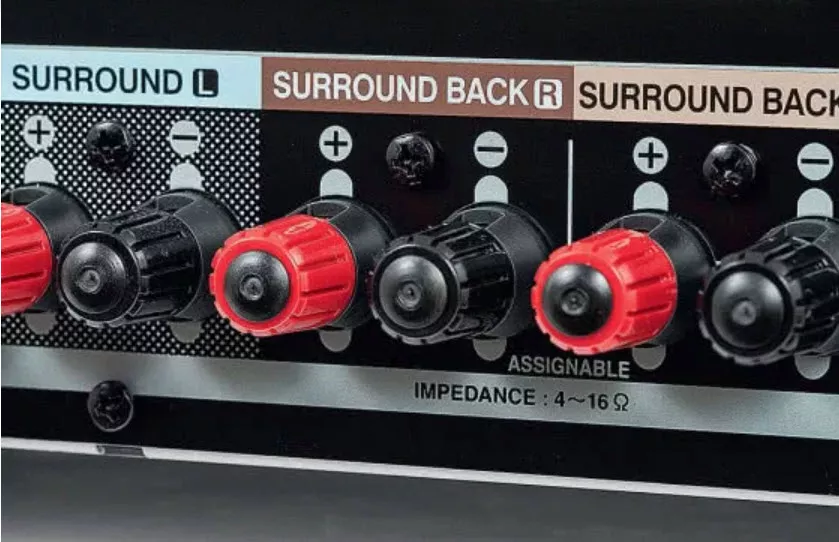
Each channel can officially work with 8-, 6- and 4-ohm loads, only the impedance selector setting and … consent for a significant power drop at lower impedances is required.
The frequency response linearity is excellent, the distortion and noise behavior very good and the channel separation is always in the green zone. The damping factor is 50, other manufacturers offer slightly higher values, but according to the philosophy of Denon developers, this value is ideal.
In stereo, the Denon AVR-X2500H delivers 110 watts into eight and 145 watts into four ohms. With a simultaneous load of five channels, the Denon delivers a remarkable 97 watts into eight and 116 watts into four ohms per channel. A protective circuitry shuts down the receiver in time if the user exaggerates the volume; this protects it from damage. After a restart, the full power can be called up again.
The seven analog amplifiers produce an enormous amount of heat, and we were able to measure more than 60 degrees (140° F) Celsius on the top of the device. Here, unhindered heat dissipation should be ensured during installation. In standby, the power consumption is a minimum of 0.1 watts and a low 2.9 watts is required for network pass-through.
Comparison With The Denon X1500H
The larger Denon X2500H has two additional HDMI inputs and an additional HDMI output (e.g. for operating a projector + TV). The Denon AVR X2500H provides 150Watt for sufficient power. For this purpose, the power amplifier section and the device layout were partially completely revised. Thus, the X2500H not only offers more connection options but should also set itself apart from its smaller twin in terms of sound
Conclusions
The Denon AVR-X2500H is an excellent sounding all-rounder with a lot of power under the chic hood and a configuration that can hardly be topped. Thanks to Heos integration, it is extensively multi-room and streaming capable and thus well equipped for all upcoming film and music tasks.
Specifications Of The Denon AVR-X2500H
- 7 x HDMI 2.0 inputs with full 4K HDR support (HDR10, Dolby Vision, HLG)
- 2 x HDMI 2.0 output for all 4K UHD content
- 1 x Bluetooth 3.0, 1 x WLAN, 1 LAN / Ethernet socket as internet connection
- 1 x phono input (e.g. for a record player)
- Front connections: (1 x USB, 1 x HDMI 2.0, 1 x headphones)
- Additional digital and optical video and audio inputs
- Radio connection (Internet, MW, UKW), HEOS Multiroom, Spotify Connect, Deezer, Pandora, TuneIn, Gapless Playback
- HiRes audio support: MP3, WMA, AAC, FLAC, ALAC, WAV, DSD128 up to 24bit / 196 kHz
- Airplay 2 (wireless integration and control by Apple devices)
- Alexa Voice Control (operation of the AV receiver via voice commands)
- Audyssey MultEQ XT measurement system (also possible via app)
Further Readings
We have some other interesting articles for you to read, we have selected our top articles below, and tried to keep this list short.
We have a technical vademecum where we discuss industry terminology and how it can be useful for you. Selected examples are the definition of PCM audio, then comes the comparison between PCM and Bitstream, the comparison between DTS Neo 2.5 and Dolby Digital, and the process to match amplifiers to speakers.
Also, we have reviewed some interesting DAC: The Elgar Plus from dCS, and the Schiit stack. where the Modi 3 behaves as an entry-level DAC.
In our reviews of AV receivers, we can recommend you to read some of our favorites, the ones that we liked the most, and trying to make the list short, we have the Denon AVR-X2500H, the Onkyo TX-NR686. We also have reviewed completely the Denon 8K receivers where we have studied the 8K Denon AVR-X2700H, the Denon AVC-X6700H, the AVC-X4700H, and the AVC-X3700H.
If you are into amplifiers, my favorite is the McIntosh MA9000, and that is why I would like to recommend you to read that review. My second favorite amplifier is the Mark Levinson 5805.
Regarding speakers, we have reviewed tiny bookshelf-speaker devices to large towers. My favorites were: the Devialet Gold, the Devialet Silver, the ProAc Response DT8, the Bowers and Wilkins 805 D3,
We do not review many headphones, but if you want a Sennheiser headphone for less than 100 dollars, we have this Sennheiser HD595 review.
We have some TV and monitor reviews and here we recommend the Samsung NU8000 (for gamers!) and my favorite is the review of the classical Pioneer Kuro.
Our home theater aficionados want to know everything about video definitions and configurations. So we studied 720p, how to scale it to 1080p the right way, and compared 1080p with 1440p and demonstrated why 1440p is not always better. Likewise, we had the urge to compare 1440k with 4K and try to find out how much are we gaining with the change.

I am Bob. I work as an audio engineer and audio technician. I work in mastering and arranging bridges in existing songs and the arrangement and orchestration of the chorus. In Planet HiFi I test gear for a couple of days and write a review. I also write about AV topics, amplifiers, speakers, and headphones.


Boothby171
Friday 6th of January 2023
A quick note for those of us not quite finished with "legacy" components (such as VCRs)--the AVR-2500H does NOT upscale composite video (yellow connector) to HDMI. If you want to watch your old VHS tapes, you will have to run a composite video line to your television/monitor.
(Yes, I realize that this particular problem will die with my generation)